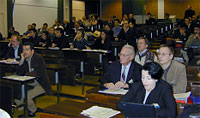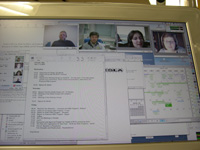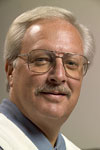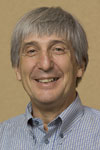CARE Collaboration
Follows Its Objectives

CARE participants (click to enlarge) |
On 23-25 November 2005, the second annual meeting of the Coordinated Accelerator Research in Europe Project (CARE) took place. Approximately 190 participants, mostly European, attended the meeting. "This meeting has once more demonstrated that the objective of CARE is a reality. It carries Accelerator Research, by integrating the European resources in a collaborative mode, as we are used to do for detectors", said CEA/DAPNIA and CPPM (Marseille) physicist Roy Aleksan, CARE Coordinator and chairman of ESGARD (European Steering Group on Accelerator R&D).
Read more...
CARE05 slides
CARE05 photos
ESGARD and CARE webpage
--Perrine Royole-Degieux
|
 |
|
|
 |
Upcoming meetings, conferences, workshops
Mini Workshop on Design
for High Availability
Hotel CARAT at Grömitz (located at the Baltic
Sea), 1-2 December 2005
ILC Spanish Meeting
Gandia, Spain, 1-3 December 2005
TESLA Technology Collaboration Meeting
Frascati, Italy, 5-6 December 2005
GDE Meeting
Frascati, Italy, 7-9 December 2005
American Linear Collider Physics Group - Detector Simulation Workshop
Boulder, Colorado, U.S.A., 9-11 January 2006
LCWS 2006
Bangalore, India, 9-15 March 2006
International School for Linear Colliders
Sokendai, Graduate School for Advanced Studies
Hayama, Japan, 19-27 May 2006
|
 |
|
|
 |

For the past several weeks, the GDE communicators have been using VRVS to have weekly videoconferences - usually early in the morning for the U.S. and late at night for Japan. Youhei Morita of KEK captured yesterday's videoconference, which was held at 7:00 a.m. in the U.S., 2:00 p.m. in Europe and 10:00 p.m. in Japan. (Don't look too closely or you will notice that the Americas communicator is still in her pajamas!)
|
|
 |
 |
|
|
 |
Role of ECFA
ILC Study Meetings

Participants' nationalities (click to enlarge) at the ECFA workshop 2005 on physics and detectors at the ILC in Vienna |
On 14-17 November, the European Committee for Future Accelerators (ECFA) sponsored an ILC workshop in Vienna, Austria. François Richard, chairman of the "Organizing Committee ECFA Study of Physics and Detectors for a Linear Collider" and GDE member, explained the purposes of these workshops.
"What are these ECFA study meetings for? Once a year and during 3.5 days, a wide spectrum of topics is presented to the ECFA community. The workshop gives its members the opportunity to express their opinions about choices and to make suggestions. It is also a place for forums which encourage new ideas and enable young talents to express themselves", said Richard.
As with the previous meetings, the agenda for the 2005 meeting was mainly driven by R&D and phenomenology. In the future, the workshop agenda will include detector concepts and a connection with the GDE.
Read more...
--Perrine Royole-Degieux
|
 |
|
|
 |
Kuchler Presents ILC
Conventional Facilities Update

Vic Kuchler |
Yesterday morning on 30 November, Vic Kuchler, an Architect at Fermilab and GDE member, provided an ILC conventional facilities update at Fermilab’s weekly ILC meeting. Kuchler together with Astushi Enomoto of KEK and Jean-Luc Baldy of CERN lead the GDE Conventional Facilities group, representing each of the three regions involved with the ILC.
Meeting via videoconference on a weekly basis, the three regional representatives along with local colleagues recently completed the conventional facilities portion of the Baseline Configuration Document (BCD). Kuchler explained that this chapter of the report includes a brief explanation of the site assessment matrix process and descriptions of the sample site(s) for each region.
Read more...
--Elizabeth Clements
|
 |
|
|
 |
From Interactions.org
24 November 2005
The People's Republic of China Plans to Participate in the European X-ray Laser Project XFEL
Within the framework of the meeting of the international XFEL Steering
Committee in Berlin, today two representatives of the People's Republic
of China's Ministry of Science and Technology signed the Memorandum of
Understanding for the European X-ray laser project XFEL.
Read more...
From CERN Courier
December 2005
ILC comes to Snowmass
In August nearly 700 scientists and engineers from North America, Asia and Europe got together at Snowmass in the US to advance the design of the International Linear Collider and its detectors, and to refine the physics case for this next-generation machine.
Read more...
|
|
 |
 |
|
|
 |
One Tunnel or Two?
Should we build the ILC using one underground tunnel? Or should we build it using two adjacent tunnels, one containing the support instrumentation and the other containing the accelerator?
These sound like innocuous questions, but they present one of the more complex and difficult problems we have been facing in forming the baseline for next year’s reference design. There are a mix of issues that need to be considered, including safety, access, reliability and cost. From our present knowledge of these factors, we have recommended the use of parallel twin bored tunnels for the "strawman" baseline, which will be discussed and finalized at Frascati next week.
Today, I want to highlight some of the considerations that went into our two tunnel recommendation, and the consequences it will have for our work next year. What are the issues? A single tunnel having a diameter of 5.2 m was proposed for TESLA, and it contained access shafts and surface halls at regular intervals (every 5km) for cryogenics and modulators housing. An alternate concept using two tunnels has been proposed, in which the RF sources and other support instrumentation are located in a separate tunnel that runs parallel and nearby to the beamline tunnel. The motivation for proposing two tunnels is that the instrumentation in the second tunnel would not be subject to radiation and could be accessed for repairs while the machine is running. The main argument against two tunnels is cost. As we understand the costs better over the next year, this may well become the critical argument.

Jean-Pierre Delahaye |
Following the technology decision and during the early phases of the new global design effort based on superconducting RF technology, the debate for two tunnels continued. Over the past year, the GDE considered both options, and the global group who looked at the configurations, made a tentative recommendation for two tunnels at Snowmass. They based this recommendation primarily on access and availability arguments. In order to bring all the arguments together to assist us in making the best choice for the baseline, we then formed a special GDE committee of Jean-Pierre Delahaye, Hitoshi Hayano and Nan Phinney to develop a "White Paper" to analyze the arguments pro and con and make a recommendation to the GDE Executive Committee.
Read more...
--Barry Barish
Director's Corner Archive
|
 |
|
|
 |
Japanese translation started
We are pleased to announce that the Japanese translation of
the ILC NewsLine is now available on the web. Each issue will
be translated into Japanese and posted on the web. You can
also be notified via e-mail by subscribing to a Japanese mail
magazine. For details, contact youhei.morita@kek.jp.
Website
Subscription
ILC Related Preprints
ILC-Asia-2005-24 - Studies of Electron Cloud, Ion Effects and Synchrobetatron
Resonances for KEKB, Super-KEKB and ILC Damping Rings, 26 Nov 2005
|
|

